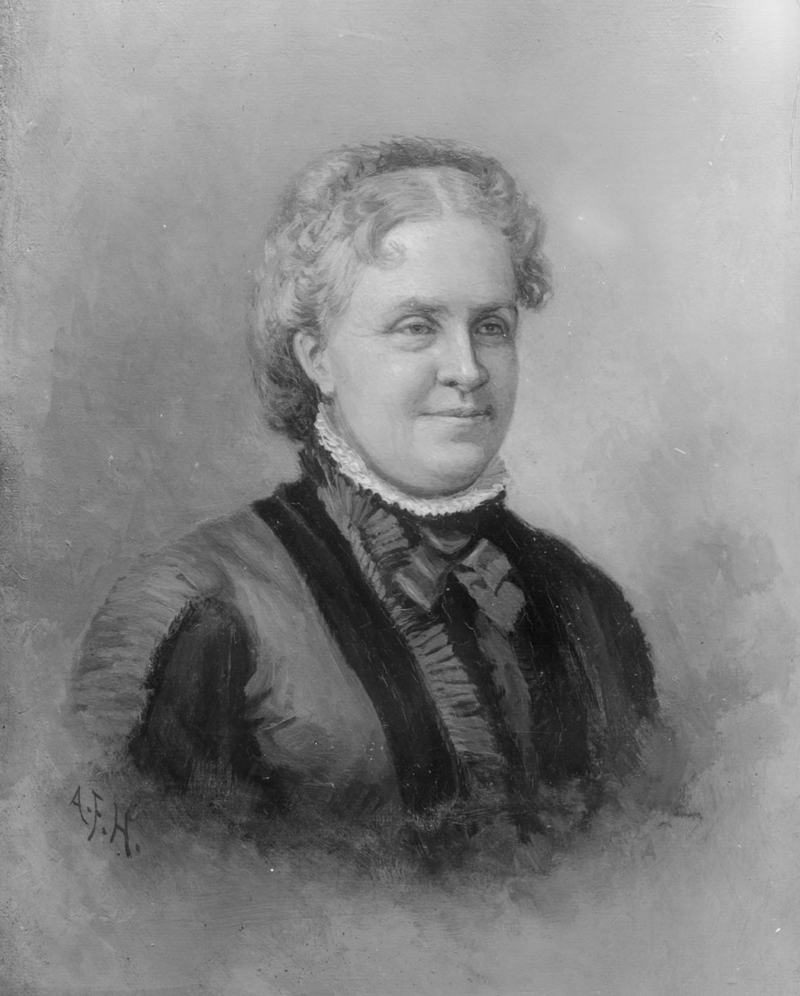|
|
By Alexander F. Harmer 1885

Click image to enlarge
Portrait, 1885, of 19th-century Indian rights activist Helen Hunt Jackson, author of several books including the 1884 novel, "Ramona," based in part on her impressions of the Del Valle family's Rancho Camulos in the western Santa Clarita Valley. Possibly painted from sittings in 1880 or 1882. The artist is Alexander Francis "A.F." Harmer, who was active in Ventura and Santa Barbara counties and was known for native American subjects and landscapes. He painted in both oil and watercolor, and his illustrations were published in Harper's Weekly and other periodicals and books. This Helen Hunt Jackson portrait appears in the book, "Through Ramona's Country" by George Wharton James (Boston: Little, Brown and Co. 1909:xii). Countless authors and publishers sought to capitalize on the popularity of Jackson's novel; this was one such emanation from the publisher of "Ramona" itself. (Little, Brown published "Ramona" from 1885 or 1886 onward; a different company, Roberts Brothers, published the 1884 first edition.) However, unlike others, which tended to made ridiculous assertions about the "real Ramona," this one is actually worth reading. The author draws a thoughtful distinction between Jackson's accurate characterizations of the landscape, the Californio lifestyle and the treatment of Indians, on the one hand, and the the wholly fictional characters on the other hand. About the Artist (from George Stern Fine Arts of West Hollywood): Alexander Harmer (1856-1925) was a painter and illustrator. Born in Newark, N.J., on Aug. 21, 1856, Harmer began painting as a child and sold his first painting at age 11. Leaving home at 13, he began a life of travel and made his way to Nebraska. After three years in Lincoln, he headed east and in Cincinnati joined the U.S. Army at age 16. After one year of service in California, he requested a discharge in order to pursue an art career. He returned to the East and enrolled at the Pennsylvania Academy of Fine Arts under Eakins and Anshutz. In order to get to the West to paint Indians, he re-enlisted in the Army in 1881 and was assigned to cavalry duty in Arizona where he participated in the Apache wars. He returned to Pennsylvania Academy sketches of the Apaches which he developed into oils and watercolors, and contributed illustrations thereof to Harper's Weekly. In the early 1890s, Harmer settled in Santa Barbara and married into one of the pioneer California families. He then switched to painting portraits and genre scenes of the vanishing life of the old missions of California during the Mexican rule. His scenes were depicted with great accuracy and detail to the costumes and surroundings of that period before California became a state. Harmer sometimes signed his works "A.F.H." or a circle with a cross of two peace pipes in the center (Apache symbol of friendship and peace). He is considered Southern California's first great painter of the 19th Century. His adobe on De La Guerra Plaza in Santa Barbara was a gathering spot for artists until his death on January 8, 1925, in that city. Exhibited: California State Fair, 1887; Alaska Yukon Expo (Seattle), 1909 (gold medal). In: Santa Barbara Museum & Historical Society; Los Angeles County Museum of Art. Reading: "Ramona" (complete text); The Home of Ramona by Charles Franklin Carter, published 1902; Rancho Camulos: National Register of Historic Places Nomination, San Buenaventura Research Associates, 1996.
LW2453: 9600 dpi jpeg from digital image (California Historical Society Collection, USC Digital Library). |
SEE ALSO:
Camulos Visit,
SoCal Observations (Odell 1939)
Portraits x2
Full Text
HHJ Gravesite 1912
I Knew Ramona, by Jose Jesus Lopez
Roberts Story 1886
Antonio Coronel Bio, HSSC 1900
"Narrow Trail" by Wyeth 1939
|
The site owner makes no assertions as to ownership of any original copyrights to digitized images. However, these images are intended for Personal or Research use only. Any other kind of use, including but not limited to commercial or scholarly publication in any medium or format, public exhibition, or use online or in a web site, may be subject to additional restrictions including but not limited to the copyrights held by parties other than the site owner. USERS ARE SOLELY RESPONSIBLE for determining the existence of such rights and for obtaining any permissions and/or paying associated fees necessary for the proposed use.








